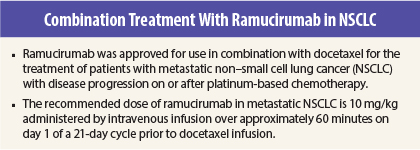In the Clinic provides overviews of novel oncology agents, addressing indications, mechanisms, administration recommendations, safety profiles, and other essential information needed for the appropriate clinical use of these drugs.
In December 12, 2014, ramucirumab (Cyramza) was approved for use in combination with docetaxel for the treatment of patients with metastatic non–small cell lung cancer (NSCLC) with disease progression on or after platinum-based chemotherapy.1,2 Patients with EGFR or ALK genomic tumor aberrations should have disease progression on approved therapy for these aberrations prior to receiving ramucirumab.
Supporting Trial
Approval was based on the finding of superior overall survival in a double-blind phase III trial (REVEL) in which 1,253 patients with previously treated metastatic NSCLC were randomized to receive ramucirumab (10 mg/kg every 3 weeks) plus docetaxel (75 mg/m2 every 3 weeks) on day 1 of a 21-day cycle (n = 628) or matching placebo plus docetaxel (n = 625).2,3 Patients had a median age of 62 years, 67% were men, 84% were white and 12% were Asian, 33% had an Eastern Cooperative Oncology Group performance status of 0, and 74% had a nonsquamous histology and 25% had a squamous histology. Patients received a median of 4.5 doses of ramucirumab, the median duration of exposure was 3.5 months, and 31% received ramucirumab for at least 6 months.
The median overall survival was 10.5 months in the ramucirumab group vs 9.1 months in the control group (hazard ratio [HR] = 0.86, P = .024). The median progression-free survival was also significantly longer in the ramucirumab group (4.5 vs 3.0 months, HR = 0.76, P < .001).
How It Works
Ramucirumab is a recombinant human immunoglobulin 1 monoclonal antibody that acts as a vascular endothelial growth factor receptor 2 (VEGFR2) antagonist. It specifically binds VEGFR2 and blocks the binding of the VEGFR ligands VEGF-A, VEGF-C, and VEGF-D. As a result of receptor blockade, ramucirumab inhibits ligand-stimulated activation of VEGFR2, thus inhibiting ligand-induced proliferation and migration of endothelial cells. Ramucirumab inhibited angiogenesis in animal models.
How It Is Given
The recommended dose of ramucirumab in metastatic NSCLC is 10 mg/kg administered by intravenous infusion over approximately 60 minutes on day 1 of a 21-day cycle prior to docetaxel infusion. Treatment should be continued until disease progression or unacceptable toxicity. All patients should be premedicated with an intravenous histamine (H1) antagonist (eg, diphenhydramine hydrochloride) prior to each infusion, and patients who have a grade 1 or 2 infusion reaction should also be premedicated with dexamethasone (or its equivalent) and acetaminophen. The infusion rate should be reduced by 50% for grade 1 or 2 infusion-related reactions, and treatment should be permanently discontinued for grade 3 or 4 infusion-related reactions.
Treatment should be interrupted in patients with severe hypertension, urine protein levels ≥ 2 g/24 hours, and prior to surgery until wounds are fully healed. It should be permanently discontinued in those with severe hypertension that cannot be managed with antihypertensive therapy, proteinuria of > 3 g/24 hours or nephrotic syndrome, arterial thromboembolic events, gastrointestinal perforation, grade 3 or 4 bleeding, or reversible posterior leukoencephalopathy syndrome.
Safety Profile
In the phase III trial, the most common adverse events of any grade occurring in the ramucirumab/docetaxel group at a rate at least 30% and at least 2% higher than in the docetaxel/placebo group were neutropenia (55% vs 46%), fatigue/asthenia (55% vs 50%), and stomatitis/mucosal inflammation (37% vs 19%). The most common grade 3 or 4 adverse events in the ramucirumab group were neutropenia (49% vs 40%), febrile neutropenia (16% vs 10%), and fatigue/asthenia (14% vs 11%), and the most common serious adverse events were febrile neutropenia (14%), pneumonia (6%), and neutropenia (5%).
Granulocyte colony-stimulating factor treatment was used in 42% of the ramucirumab group and 37% of the control group. Pulmonary hemorrhage occurred in 7% (grade ≥ 3 in 1%) vs 6% (grade ≥ 3 in 1%) of patients with a nonsquamous histology and 10% (grade ≥ 3 in 2%) vs 12% (grade ≥ 3 in 2%) of patients with a squamous histology.
Adverse events led to discontinuation of treatment in 9% vs 5%, with the most common reasons in the ramucirumab group consisting of infusion-related reaction (0.5%) and epistaxis (0.3%). Death on treatment or within 30 days of discontinuing treatment occurred in 8% vs 4% of patients older than age 65 and in 3% vs 6% of patients younger than age 65.
Ramucirumab carries a boxed warning for hemorrhage, including fatal bleeding. It also has warnings/precautions for arterial thromboembolic events (sometimes fatal), hypertension, infusion-related reactions, gastrointestinal perforation, impaired wound healing, clinical deterioration in patients with cirrhosis (including new onset or worsening encephalopathy, ascites, or hepatorenal syndrome), and reversible posterior leukoencephalopathy syndrome. Ramucirumab may cause fetal harm, and nursing mothers should discontinue nursing or discontinue ramucirumab.
Report Adverse Events
Health-care professionals should report all serious adverse events suspected to be associated with the use of any medicine or device to FDA’s MedWatch Reporting System by completing a form online at http://www.fda.gov/medwatch/report.htm, by faxing (1-800-FDA-0178), by mailing the postage-paid address form provided online, or by telephone (1-800-FDA-1088). ■
References
1. U.S. Food and Drug Administration: Approved drugs. Ramucirumab (Cyramza). Available at www.fda.gov/Drugs/InformationOnDrugs/ApprovedDrugs/ucm426735.htm. Accessed January 7, 2015.
2. Cyramza (ramucirumab) injection, for intravenous use, prescribing information, Eli Lilly and Company, December 2014. Available at www.accessdata.fda.gov/drugsatfda_docs/label/2014/125477s007lbl.pdf. Accessed January 7, 2015.
3. Garon EB, Ciuleanu TE, Arrieta O, et al: Ramucirumab plus docetaxel versus placebo plus docetaxel for second-line treatment of stage IV non-small-cell lung cancer after disease progression on platinum-based therapy (REVEL): A multicentre, double-blind, randomised phase 3 trial. Lancet 384:665-673, 2014.


